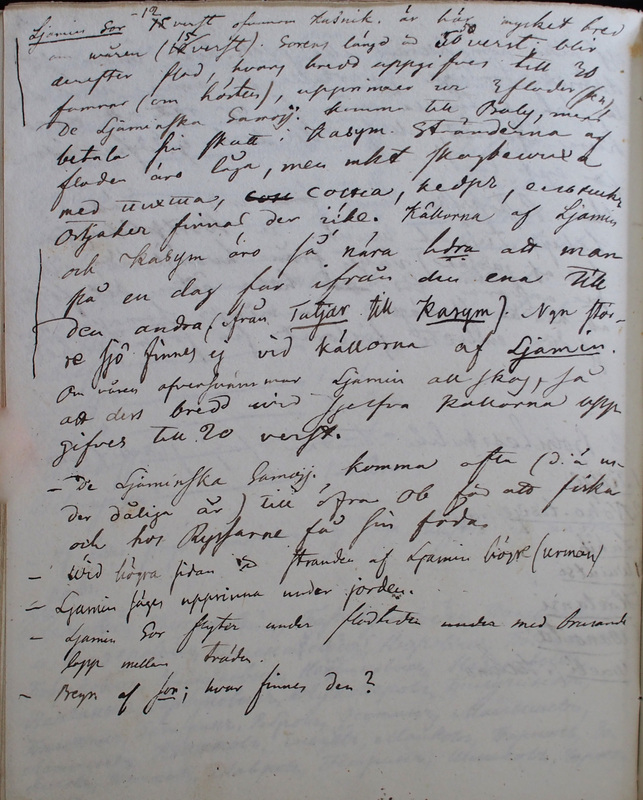Ethnographiska, historiska och statistiska anmärkningar. 238
Title
Ethnographiska, historiska och statistiska anmärkningar. 238
Description
|
Ljamin Sor
12 verst ofvanom
Ljamin Sor. The place where the River Ljamin flows into the Obʹ. N61°19’17’’E71°48’08’’.
Kuŝnik.
[ova] är här mycket bredThe River Kušnikovskaja.
om wåren (15 verst). Sorens längd är 50 verst; blir derefter flod, hvars bredd uppgifves till 30 famnar (om hösten), upprinner ur 3 floder (sen[are]). De Ljaminska Samojj.[Samojeder]
komm till
The next seven pages relate to what Castrén calls the Ljamin or Kazym Samoyeds. The denomination refers to one of the territorial communities of the speakers of the Forest variety of Nenets, who live around the Rivers Kazym and Ljamin. The Forest Nenets have also been named Konda Samoyed (kondinskie samoedy; see [page 239]). In addition, historical sources mention kunnaja Samoyed (or kunnaja Samojadʹ), which does not refer to a territory, but to the skins of fur-bearing animals (pine marten, squirrel, sable) to which the indigenous peoples were related by the Russians. Moreover, there are Forest Nenets living along the Rivers Pur and Agan. Tundra Nenets пяʹ хасава, endonym нещаʹ. (See Alekseev (ed.) 2010: 241–248; Zenʹko-Nemičinova 2006: 4–10). Castrén was the first to describe the language variety.
Baly,
mestRefers to Baly yurts, which Castrén mentions in his letter written as a travel report to Sjögren in December 1845. (Castrén 2019: 1050–1051)
betala sin skatt i Kasym.
Stränderna afThe Kazym flows into the Obˈ from the right (south) at N64°6′6″ E66°2′9″. (TS)
floden äro låga, men mkt[mycket] skogbewuxa med пихта,
Ru pichta ʻSiberian fir’ (Abies sibirica).
сосна,
Ru sosna ʻpine’ (Pinus).
кедрь,
Ru sibirskij kedrʹ ʻSiberian pine’ (Pinus sibirica).
ельникъ.
Ru elʹnik ʻspruce forest’.
Ostjaker finnas der icke. Källörna af Ljamin och Kasym äro så nära hdra[hvarandra] att man på endag far ifrån den ena till den andra (ifrån Tatjar till Kasym). Ngn[Någon] stör- re sjö finnes ej vid källorna af Ljamin. Om våren ofversvämmar Ljamin all skog, så att dess bredd wid sjlelfva källorna upp gifves till 20 verst. |
The Ljamin Sor, 12 versts above Kuŝnikova, is very wide here during the spring (15 versts). The length of the Sor is 50 versts; it becomes a river after that; its width is stated to be 30 fathoms (in autumn); it originates from three rivers. The Ljamin Samoyeds came to Baly; most of them pay their taxes in Kasym. The shoreline of the river is low, but very heavily forested with Siberian fir, pine, Siberian pine, and spruce.
There are now Ostyaks. The sources of the Ljamin and Kasym are so close to each other that one can go from one to the other in one day (from Tatyar to Kasym). There are not any bigger lakes at the source of the Ljamin. In the spring, the Ljamin floods all the forest, so that its width at its source is up to 20 versts. |
| De Ljaminska Samojj.[Samojeder] komma ofta (d. ä. m. der dåliga år) till östra Ob för att fiska och hos Ryssarne få sin föda. |
The Ljamin Samoyeds often (in other words, during bad years) come to the eastern Ob to fish and to obtain food from the Russians. |
| Wid högra sidan är stranden af Ljamin högre (urmon) |
On the right-hand side the shore of the Ljamin is higher (urmon). |
| Ljamin säges upprinna under jorden. |
The Ljamin is said to originate underground. |
| Ljamin Sor flyter under flodtiden med brusande lopp mellan träden. |
The Ljamin Sor flows at great speed between the trees during the flood. |
| Begr[afningsplats]. af sor; hvar finnes den ? |
Burial ground of sor; where is it? |

